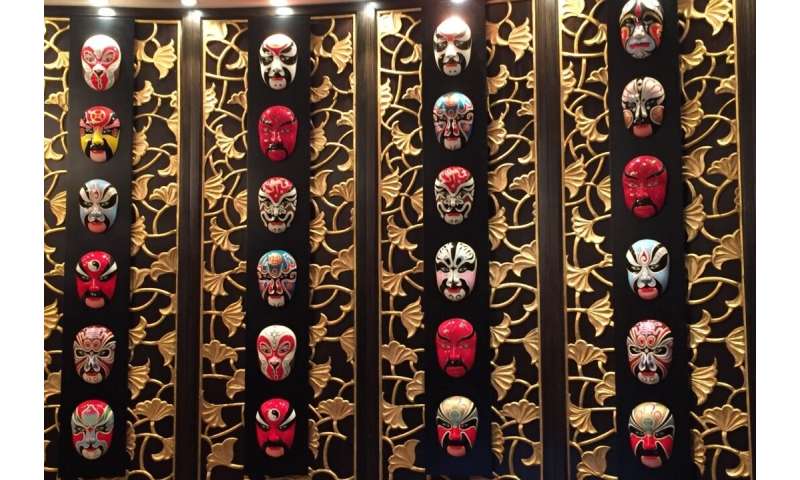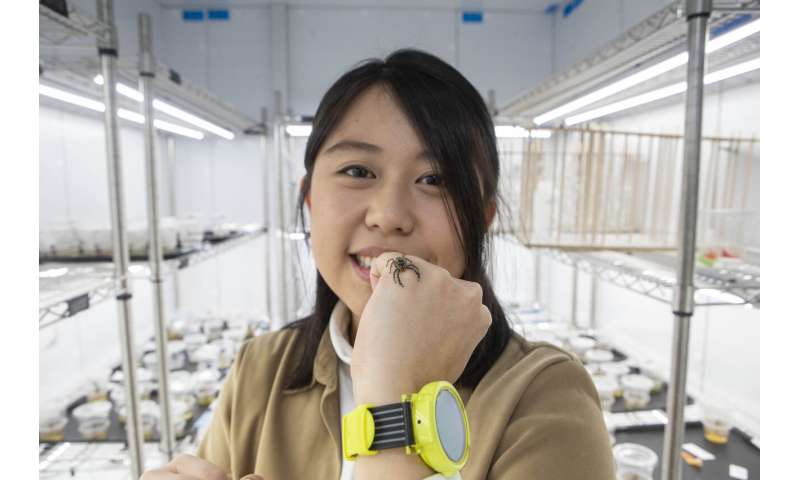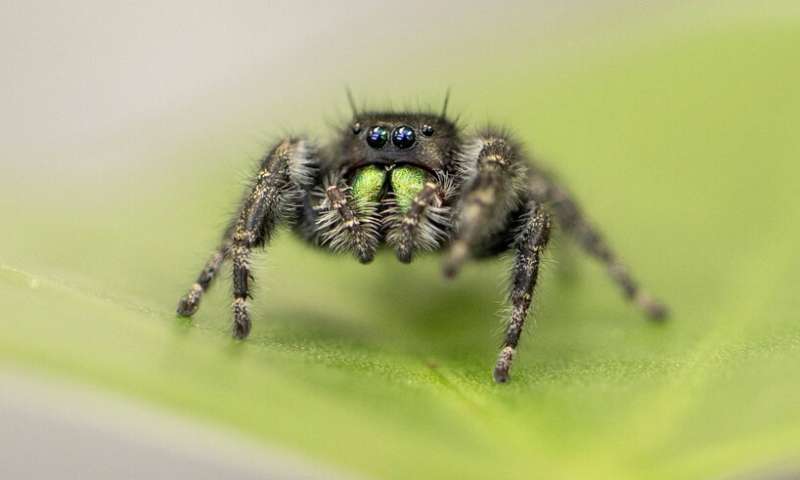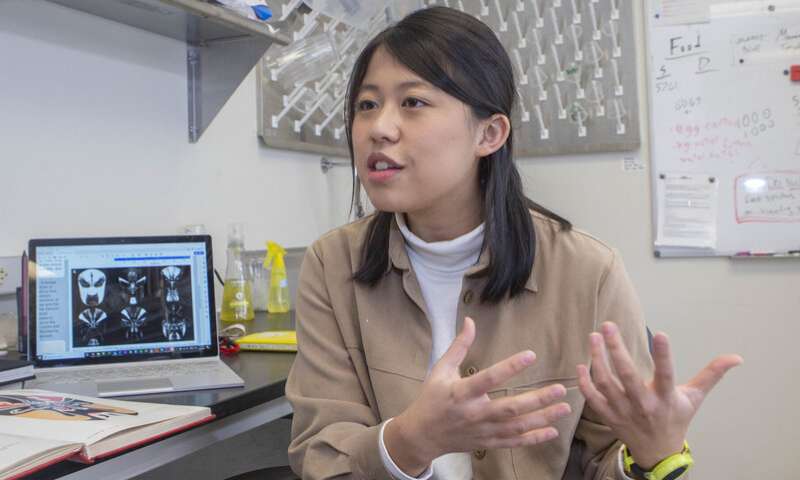
To better understand how animals like spiders communicate with pattern and color, a University of Cincinnati biology student is turning to ancient dramatic art.
Biology doctoral student Jenny Yi-Ti Sung is studying how Beijing operas that date back thousands of years convey details about motivation and character to their audiences through the performers' colorful masks.
Like many jumping spiders, Chinese opera masks, or Jing masks, have unique patterns and colors that convey information to their intended audience. For spiders, the unique characteristics broadcast species, sex or even romantic intentions to possible mates. In Chinese opera, the masks help the audience instantly recognize heroes, villains, allies, foes and other supporting characters amid the frenetic action on stage.
"I'm interested in understanding how male spiders might use their patterns and colors to tell a female spider they're the same species and are a viable mate," Sung said. "I saw a parallel in Chinese opera masks. How do these visual patterns evolve to tell a specific identity?"
Sung presented her ongoing project to the Society for Integrative and Comparative Biology conference in January. She is looking at whether the Jing masks are more alike or different within a particular opera compared to masks in unrelated operas.
"If the masks are in the same story, it follows that they are under selection for distinctiveness. So, they should show greater differences compared to masks in another opera," she said.
Sung examined 76 masks painted by artist Steve Lu in his 1968 book "Face Painting in Chinese Opera." Sung digitally scanned and resized the images for uniformity for her computer analysis.
Villains are often depicted in white with striking patterns. The hero traditionally wears a red mask with fewer adornments.
"He's very virtuous. He doesn't have many features on his face, which suggests he's calm, composed and mature," Sung said.

Most have symmetrical features that accentuate the character's mood or personality.
"It's rare for characters to have asymmetrical features. But that might be a nod to the audience that this character can't be trusted," she said.
Other recurring archetypes are the loyal friend and the Monkey King, which features a flat monkey-shaped nose and round muzzle.
"It's not just the face but the costume and performance. He jumps around the stage like a monkey," Sung said.
Sung subjected 76 masks to what's called an eigenface analysis, a computerized breakdown that can identify the most common or unique characteristics of faces. The analysis identified the facial features that were most similar or different in the 76 examples.
Sung's computer analysis also generated a grayscale version of the mean face (as in arithmetic mean rather than mean-looking) depicted in the 76 masks. The mean face features a patterned nose and forehead, heavily shadowed eyes and shaded mouth.
"This is what the computer considers the average of all 76 masks after doing some cool math kung fu, the covariance that shows the differences between the masks," Sung said.
Next, Sung plans to plot each mask to the eigenface dimensions and calculate Euclidean distances to investigate whether the masks that appear in the same opera have more variation than those in unrelated operas. This would suggest it's more important in Chinese opera to differentiate characters in the same story as opposed to characters in different stories, Sung said.
Sung said she has gotten positive feedback on her novel approach so far from peers at conferences.

"This is a delightful marriage of cultural interest and heritage with scientific interest in evolutionary biology," said Nathan Morehouse, an associate professor of biology at UC and Sung's advisor. "I think it's wonderful."
Facial patterns have recurring biological significance across species, Morehouse said.
"Jumping spiders have lots of colors and patterns on their faces that communicate information about what species they are, what sex they are and whether they're a good mate," he said.
Besides spiders, facial pattern recognition is found in many other animals, including a genus of primates called guenons. Many of these African monkeys share the same habitats where it would be advantageous to distinguish members of the same species at a distance, Morehouse said.
"When they live in mixed-species communities, their facial patterns evolve to be distinct so they can recognize each other," Morehouse said.

Morehouse said he applauds Sung's creative approach to a traditional biological discussion.
"In our lab we're always challenging ourselves to think creatively about the questions we ask," he said about the Morehouse Lab on the UC Uptown campus. "I think it enriches science and opens up new ways of thinking about things."
Sung said she hopes the study will shed light on evolutionary divergence, the fork in the road where members of the same species head in different genetic directions.
"Of course, there's no punishment to the audience if they don't recognize the faces properly. But in the wild, you'd get eaten," she said.
Explore further
Citation: What do Chinese opera masks and spiders have in common? A lot, as it turns out. (2020, January 25) retrieved 25 January 2020 from https://phys.org/news/2020-01-chinese-opera-masks-spiders-common.html
This document is subject to copyright. Apart from any fair dealing for the purpose of private study or research, no part may be reproduced without the written permission. The content is provided for information purposes only.
https://news.google.com/__i/rss/rd/articles/CBMiRWh0dHBzOi8vcGh5cy5vcmcvbmV3cy8yMDIwLTAxLWNoaW5lc2Utb3BlcmEtbWFza3Mtc3BpZGVycy1jb21tb24uaHRtbNIBRGh0dHBzOi8vcGh5cy5vcmcvbmV3cy8yMDIwLTAxLWNoaW5lc2Utb3BlcmEtbWFza3Mtc3BpZGVycy1jb21tb24uYW1w?oc=5
2020-01-25 08:18:27Z
CAIiEKdOjflNdY_h9Dolf1q3fPIqFwgEKg8IACoHCAowpbDpAzCm_hwwj9kp
Bagikan Berita Ini














0 Response to "What do Chinese opera masks and spiders have in common? A lot, as it turns out. - Phys.org"
Post a Comment